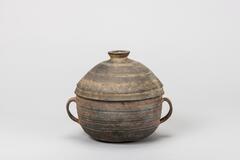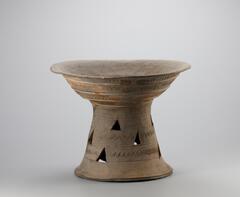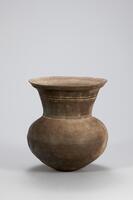8 UMMA Objects
8 UMMA Objects
![<p>This bowl is typical of early-Goryeo celadon in terms of shape and pattern. Similar examples have been excavated from sedimentary layers from the Kiln no. 10 at Yongun-ri, Gangjin-gun, Jeollanam-do. The entire inner wall is decorated with chrysanthemum sprays incised in fine lines. Chrysanthemum spray design is commonly found in Goryeo celadon produced between the 10th and the 11th centuries along with the motifs of chrysanthemum, scroll, cloud, parrot, and wave. The design is resemblent to those found in Yue ware, but the clay and glaze were sintered better and the glaze was exquisitely fused to turn into the beautiful color without crackles. Six refractory spurs were used to support the bowl during firing. The bowl was restored after a breakage into two halves.<br />
[<em>Korean Collection, University of Michigan Museum of Art </em>(2014) p.92]</p>
<br />
Stoneware bowl with celadon glaze. The bowl is decorated by an incised line stretching parallel to the rim, bounding a chrysanthemum design below. <p>This bowl is typical of early-Goryeo celadon in terms of shape and pattern. Similar examples have been excavated from sedimentary layers from the Kiln no. 10 at Yongun-ri, Gangjin-gun, Jeollanam-do. The entire inner wall is decorated with chrysanthemum sprays incised in fine lines. Chrysanthemum spray design is commonly found in Goryeo celadon produced between the 10th and the 11th centuries along with the motifs of chrysanthemum, scroll, cloud, parrot, and wave. The design is resemblent to those found in Yue ware, but the clay and glaze were sintered better and the glaze was exquisitely fused to turn into the beautiful color without crackles. Six refractory spurs were used to support the bowl during firing. The bowl was restored after a breakage into two halves.<br />
[<em>Korean Collection, University of Michigan Museum of Art </em>(2014) p.92]</p>
<br />
Stoneware bowl with celadon glaze. The bowl is decorated by an incised line stretching parallel to the rim, bounding a chrysanthemum design below.](/media/W1siZiIsIjIwMjIvMDkvMjQvM2djdWZxdmhieV9kZWZhdWx0LmpwZyJdLFsicCIsInRodW1iIiwiMjQweDIwMCJdXQ?sha=8591e65ef730993a)
Korean (Korean (culture or style))
Bowl with Chrysanthemum Design
900 – 1099
Gift of Bruce and Inta Hasenkamp and Museum purchase made possible by Elder and Mrs. Sang-Yong Nam
2004/1.220

Korean (Korean (culture or style))
Two-handled bowl with cover
400 – 599
Gift of Bruce and Inta Hasenkamp and Museum purchase made possible by Elder and Mrs. Sang-Yong Nam
2004/1.182A&B

Korean (Korean (culture or style))
Large bowl or stand on high cut-out pedestal foot
5th century
Gift of Bruce and Inta Hasenkamp and Museum purchase made possible by Elder and Mrs. Sang-Yong Nam
2004/1.177
![<p>This bowl is an example of an early celadon influenced by Chinese Yue ware. Similar vessels have been excavated from sedimentary layers of the Kiln no. 10 at Yongun-ri, Gangjin-gun, Jeollanam-do. The design, which features two parrots with their wings spread around the bowl’s inner wall, is also similar to the design found in Yue ware. This piece counts as medium quality ware, since its glaze is poorly fused. Refractory spurs are stuck around the rim, while the glaze has flowed downwards. There are six refractory spur marks on the shallow foot.<br />
[<em>Korean Collection, University of Michigan Museum of Art</em> (2014) p.90]</p>
Stoneware teabowl with celadon glaze. A pair of parrots is incised on he inside of the bowl, as well as a line that runs slightly below and parallel to the rim. <p>This bowl is an example of an early celadon influenced by Chinese Yue ware. Similar vessels have been excavated from sedimentary layers of the Kiln no. 10 at Yongun-ri, Gangjin-gun, Jeollanam-do. The design, which features two parrots with their wings spread around the bowl’s inner wall, is also similar to the design found in Yue ware. This piece counts as medium quality ware, since its glaze is poorly fused. Refractory spurs are stuck around the rim, while the glaze has flowed downwards. There are six refractory spur marks on the shallow foot.<br />
[<em>Korean Collection, University of Michigan Museum of Art</em> (2014) p.90]</p>
Stoneware teabowl with celadon glaze. A pair of parrots is incised on he inside of the bowl, as well as a line that runs slightly below and parallel to the rim.](/media/W1siZiIsIjIwMjIvMDkvMjQvMjU3MndxZ205aF9kZWZhdWx0LmpwZyJdLFsicCIsInRodW1iIiwiMjQweDIwMCJdXQ?sha=541f89daf7d4e36c)
Korean (Korean (culture or style))
Bowl with Double-Parrot Design
11th century
Gift of Bruce and Inta Hasenkamp and Museum purchase made possible by Elder and Mrs. Sang-Yong Nam
2004/1.213
![<p>Despite some glaze runnings, this high-quality vessel serves as a ne example of the 12th and 13th century celadon that features a good quality of clay body, glazed surface and glaze color. Its outer rim has a fret-patterned band,and on the outer wall are inlaid peony spray designs in three places. The mouth rim curves inwards slightly. The foot is low and has traces of silica spur, as well as cracks in two places.<br />
[<em>Korean Collection, University of Michigan Museum of Art </em>(2014) p.119]<br />
</p>
Rounded tea bowl with celadon glaze. A lightly incised peony design is spaced along the widest stretch of the cup, and below the rim is an incised fret pattern. <p>Despite some glaze runnings, this high-quality vessel serves as a ne example of the 12th and 13th century celadon that features a good quality of clay body, glazed surface and glaze color. Its outer rim has a fret-patterned band,and on the outer wall are inlaid peony spray designs in three places. The mouth rim curves inwards slightly. The foot is low and has traces of silica spur, as well as cracks in two places.<br />
[<em>Korean Collection, University of Michigan Museum of Art </em>(2014) p.119]<br />
</p>
Rounded tea bowl with celadon glaze. A lightly incised peony design is spaced along the widest stretch of the cup, and below the rim is an incised fret pattern.](/media/W1siZiIsIjIwMjIvMDkvMjQvbTVxdXo2eng4X2RlZmF1bHQuanBnIl0sWyJwIiwidGh1bWIiLCIyNDB4MjAwIl1d?sha=45dbe70ed5a40ad0)
Korean (Korean (culture or style))
Cup with incised fret pattern at rim and peony sprays on the side
1100 – 1132
Gift of Bruce and Inta Hasenkamp and Museum purchase made possible by Elder and Mrs. Sang-Yong Nam
2004/1.226
![This grayish-blue stoneware jar has a globular body and short, a little flared neck. The surface of the body is adorned with a wave design and encircled with two thin incised lines. The base is flat.<br />
<br />
This is a dark gray, bottle-shaped, high-fired stoneware vessel. Its short neck briefly slopes inwards and smoothly connects to a mouth that curves outwards. The rim is slightly rounded. The body is widest at its middle, which is surrounded by two thin incised lines with a wave design in between. The base is flat, without a foot, but has raised edges.
<p>[Korean Collection, University of Michigan Museum of Art (2017) p. 76]<br />
</p>
This grayish-blue stoneware jar has a globular body and short, a little flared neck. The surface of the body is adorned with a wave design and encircled with two thin incised lines. The base is flat.<br />
<br />
This is a dark gray, bottle-shaped, high-fired stoneware vessel. Its short neck briefly slopes inwards and smoothly connects to a mouth that curves outwards. The rim is slightly rounded. The body is widest at its middle, which is surrounded by two thin incised lines with a wave design in between. The base is flat, without a foot, but has raised edges.
<p>[Korean Collection, University of Michigan Museum of Art (2017) p. 76]<br />
</p>](/media/W1siZiIsIjIwMjIvMDkvMjQvOTBtdjkyc2tqbV9kZWZhdWx0LmpwZyJdLFsicCIsInRodW1iIiwiMjQweDIwMCJdXQ?sha=b733fe287d74ad57)
Korean (Korean (culture or style))
Small Storage Jar
500 – 699
Gift of Bruce and Inta Hasenkamp and Museum purchase made possible by Elder and Mrs. Sang-Yong Nam
2004/1.171

Korean (Korean (culture or style))
Round-Bottomed Jar with Wide Flared Mouth
400 – 599
Gift of Bruce and Inta Hasenkamp and Museum purchase made possible by Elder and Mrs. Sang-Yong Nam
2004/1.183
![Stoneware lotus-shaped cup and stand with celadon glaze. The cup is shaped in the style of a ten-lobed lotus blossom. On each lobe lies lightly incised chrysanthemum decoration. The cup rests on a pedestal in the design of an inverted lotus flower, which rises from the dish-like base of the stand, mounted on a fluted foot.
<p>This is a flower-shaped cup and stand which offers a good demonstration of the formal splendor of 12th century Goryeo celadon despite yellow-borwn coloration in places. Both the cup and stand have ten lobes and they were produced using molds. On each of the ten lotus petals of the cup and stand is incised a chrysanthemum, and another chrysanthemum design is incised on the upper part of the stand where the cup rests. Around the pedestal on where the cup sits is a band of inverted lotus petals. Each foot of the cup and stand has refractory spur marks.<br />
[<em>Korean Collection, University of Michigan Museum of Art</em> (2014) p.125]<br />
</p>
Stoneware lotus-shaped cup and stand with celadon glaze. The cup is shaped in the style of a ten-lobed lotus blossom. On each lobe lies lightly incised chrysanthemum decoration. The cup rests on a pedestal in the design of an inverted lotus flower, which rises from the dish-like base of the stand, mounted on a fluted foot.
<p>This is a flower-shaped cup and stand which offers a good demonstration of the formal splendor of 12th century Goryeo celadon despite yellow-borwn coloration in places. Both the cup and stand have ten lobes and they were produced using molds. On each of the ten lotus petals of the cup and stand is incised a chrysanthemum, and another chrysanthemum design is incised on the upper part of the stand where the cup rests. Around the pedestal on where the cup sits is a band of inverted lotus petals. Each foot of the cup and stand has refractory spur marks.<br />
[<em>Korean Collection, University of Michigan Museum of Art</em> (2014) p.125]<br />
</p>](/media/W1siZiIsIjIwMjIvMDkvMjQvNTA5OTU5ejlueV9kZWZhdWx0LmpwZyJdLFsicCIsInRodW1iIiwiMjQweDIwMCJdXQ?sha=8be6ea5375b251fd)
Korean (Korean (culture or style))
Lobed Lotus-Shaped Cup and Stand with incised floral patterns
12th century
Gift of Bruce and Inta Hasenkamp and Museum purchase made possible by Elder and Mrs. Sang-Yong Nam
2004/1.235A&B
Loading…
